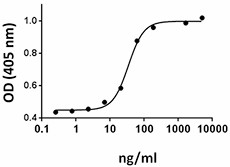- Regulatory Status
- RUO
- Other Names
- Bone morphogenetic protein 6, VGR1

-

Human BMP-6 induces ALP in chondrogenic ATDC5 cells.
| Cat # | Size | Price | Quantity Check Availability | ||
|---|---|---|---|---|---|
| 595502 | 10 µg | $218.00 | |||
This product is not available for shipping outside of the United States.
Select size of product is eligible for a 40% discount! Promotion valid until December 31, 2024. Exclusions apply. To view full promotion terms and conditions or to contact your local BioLegend representative to receive a quote, visit our webpage.
Bone morphogenetic proteins (BMPs) belong to the transforming growth factor beta (TGF-β) superfamily. BMPs play a key role in embryonic development, especially during heart, neural, and cartilage development. Around 20 BMP family members have been identified and characterized. BMPs signal through serine/threonine kinase receptors, composed of type I and II subtypes. Four type I receptors have been identified: type IA and IB BMP receptors, type IA activin receptor, and activin receptor-like kinase I (ALK-1). Three type II receptors have also been recognized: type II BMP receptor and type II and IIB activin receptors. Human recombinant BMP-6 can restore bone in animal models of osteoporosis. BMP-6 induces bone formation through IGF-I and EGF pathways in a murine model of osteopenia and in human osteoblasts. BMP-6 has been reported to have an antiproliferative effect on B, T cells, and macrophages. Also, BMP-6 induced expression of pro-inflammatory inducible nitric oxide synthase (iNOS), TNF-α and IL-1β in macrophages. In addition, BMP-6 is a key endogenous regulator of hepcidin expression and iron metabolism in vivo. In fact, BMP-6 null mice have a phenotype that resembles mouse models of juvenile hemochromatosis (an iron overload disorder caused by mutations in the genes encoding the major iron regulatory hormone hepcidin and hemojuvelin).
Product Details
- Source
- Human BMP-6, amino acids (Val344-His460) (Accession# BC099625), was expressed in HEK 293 cells.
- Molecular Mass
- The 117 amino acid recombinant protein has a predicted molecular mass of approximately 13 kD. Recombinant human BMP-6 is a 26.2 kD homodimeric glycoprotein. The predicted N-terminal amino acid is Val.
- Purity
- >95%, as determined by Coomassie stained SDS-PAGE and HPLC analysis.
- Formulation
- Lyophilized
- Endotoxin Level
- Less than 0.1 ng per µg of protein.
- Storage & Handling
- Unopened vial can be stored at -20°C or -70°C. For maximum results, quick spin vial prior to opening. Reconstitute in water to a concentration of 0.1-1.0 mg/ml. Do not vortex. It is recommended to further dilute in a buffer containing a carrier protein such as 0.1% BSA and store working aliquots at -20°C to -80°C. Avoid repeated freeze/thaw cycles.
- Activity
- BMP-6 induces alkaline phosphatase production on ATDC-5 cells. The ED50 = 0.03 - 0.06 µg/ml, corresponding to a specific activity of 1.6 - 3.3 x 104 unit/mg.
- Application
-
Bioassay
- Product Citations
-
Antigen Details
- Structure
- Growth factor, Homodimer
- Distribution
-
Hepatocytes
- Function
- Osteoblast differentiation, bone regeneration. Antiproliferative effect on B, T cells, and macrophages. BMP-6 regulates hepcidin expression and iron metabolism in vivo.
- Ligand/Receptor
- BMP receptors Alk-2 and Alk-3 (type I), BMPRII (type II)
- Cell Type
- Embryonic Stem Cells, Hematopoietic stem and progenitors, Mesenchymal Stem Cells, Neural Stem Cells
- Biology Area
- Angiogenesis, Cell Biology, Neuroscience, Stem Cells, Synaptic Biology
- Molecular Family
- Cytokines/Chemokines, Growth Factors
- Antigen References
-
1. Chen D, et al. 2004. Growth Factors 22:233.
2. Grasser WA, et al. 2007. Int. Orthop. 31:759.
3. Sivertsen EA, et al. 2007. Eur. J. Immunol. 37:2937.
4. Andriopoulos B, et al. 2009. Nat. Genetics 41:482.
5. Hong JH, et al. 2009. Immunology 128:e442.
6. Lee GT, et al. 2011. Mol. Immunol. 48:1540. - Gene ID
- 654 View all products for this Gene ID
- UniProt
- View information about BMP-6 on UniProt.org
